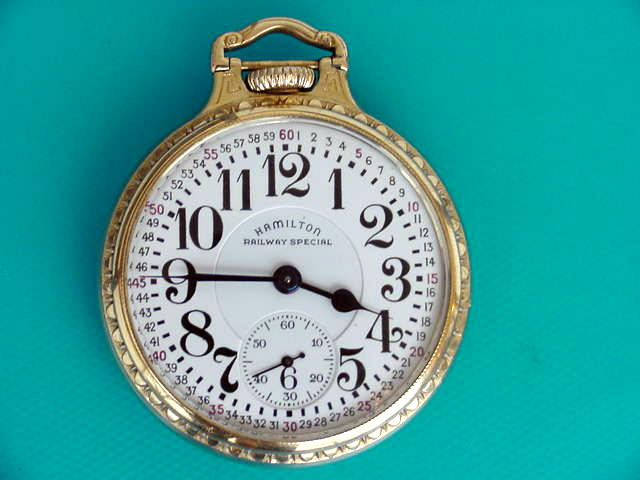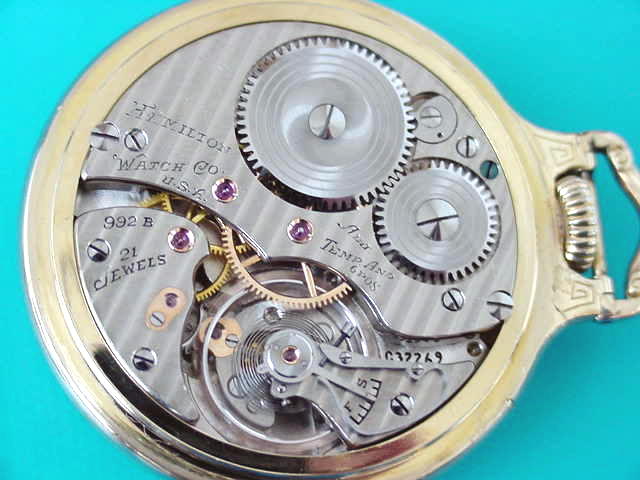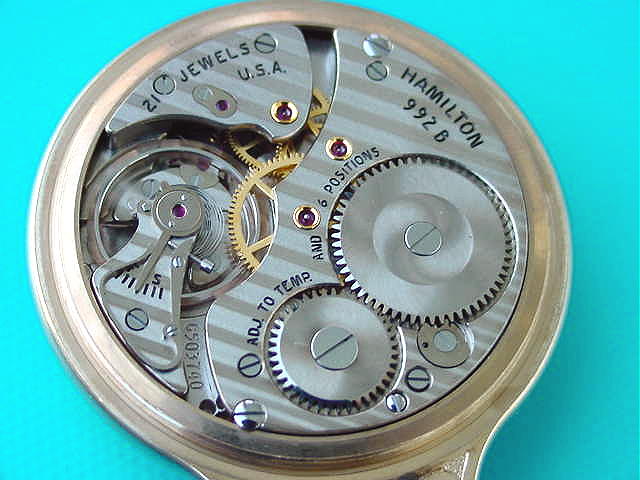
| WWT Shows | CLICK TO: Join and Support Internet Horology Club 185™ | IHC185™ Forums |

|
• Check Out Our... • • TWO Book Offer! • |
Welcome Aboard IHC185™  Internet Horology Club 185
Internet Horology Club 185  IHC185™ Discussion Site Main Page
IHC185™ Discussion Site Main Page  Horological Discussions, Questions and Answers
Horological Discussions, Questions and Answers  Pocket Watch Discussions
Pocket Watch Discussions  Hamilton 992b Why do we like these watches.
Hamilton 992b Why do we like these watches.
 Internet Horology Club 185
Internet Horology Club 185  IHC185™ Discussion Site Main Page
IHC185™ Discussion Site Main Page  Horological Discussions, Questions and Answers
Horological Discussions, Questions and Answers  Pocket Watch Discussions
Pocket Watch Discussions  Hamilton 992b Why do we like these watches.
Hamilton 992b Why do we like these watches.Go  | New Topic  | Find-Or-Search  | Notify  | Tools  | Reply to Post  |  |
| IHC Member 376 Watchmaker |
I have been ask the Question why do you and other collectors and watchmakers like the Hamilton 992b so much and what makes them such great watches. I was Asked this question by a new member. I think when Hamilton put the 992b out in 1940 the Technology for tooling that was used in the making of the 992b had advanced more than in the earlier years ,the parts in the 992b can easily been exchanged from watch to watch ,this was much harder to do in some of the early watches,they were equipped with the white elvinar hairspring and a mainspring that will give you 50+ hours of run time.If you have never owned a 992b i think once you do buy one and check the time keeping and quailty of these you will agree they are great watches. In the last few years of the Great American railroad watches fron Elgin ,Hamilton and Waltham there was some truly high grade watches made such as the Elgin 571 the Waltham 23 jewel Vanguard but my favorite is still the Hamilton 992b and 950b.. There is some great watchmakers and advanced collectors in chapter 185 maybe they can add some more info. for us on the 992b and some of the other great watches made in the last decades of the great american railroad watches. Here is a second year 992b with a procelian dial i like the early ones because of the nice dials and the gold center wheel.  | ||
|
| IHC Member 376 Watchmaker |
The movement  | |||
|
| IHC Member 376 Watchmaker |
Here is a movement from one of the last ones made. This one was a christmas present for one of our 185 members (a lucky guy down in Florida)  | |||
|
| IHC Life Member |
Nice watch old man | |||
|
As a watchmaker, the 992B is a unique watch. It is just a hint of what "might have been" had quartz technology not appeared. America perfected the machine-made pocket-watch. We tend to picture the manufacture of our vintage watches in terms of rows of skilled watchmakers. The factories HAD those but our watches were unique because their parts were machine-made. I understand that the machine for making staffs was just HUGE.... spitting the tiny things into a jar of mineral oil and followed by machine tumbling for polish. The 992B was a quantum leap ahead. With the 992B, parts could be made with such precision that their fit required absolutely no matching. I understand that before the 992B, for instance, both plates had to be drilled together, to assure alignment of jewel holes. THAT is why, the plates were numbered and matched. With the 992B, this was not necessary. On the timing machine, the 992B will usually run with a "single-line" beat, indicating precise alignment of all parts and near-perfection of function. A "single-line" beat is only achieved by the very finest of older watches (or occasionally, by sheer luck). But, in the 992B, it was ordinary and expected. This translates into near perfect timekeeping, under all conditions, including exposure to high magnetic fields. Here's something to argue about. If the 992B can consistently achieve a single-line beat, is the 950B really any better? My own opinion is that is is NOT! I LIKE the idea of jeweling the mainspring barrel pivots ( it may add to reliability) and that big, red jewel makes the movement handsome but.... having worked on both 992B and 950B's, I cannot say that the extra jewels have or could improve "perfection." | ||||
|
I think I read that the 950B was not brought into government service because of the added vulnerability to damage. There is a point of diminished returns in this regard. The 950B initial acquisition cost would have been more, and the added non-availability due to maintenance would have increased. This does not even account for the logistical cost of transport to and from a repair facility. Was not the “Jewel war” started by Hampden or Ball? | ||||
|
not sure it was a vulnerability to damage issue. More of an issue with the availability of jewels. With the two extra jewels serving a longevity function rather than a timekeeping function, it was an easy decision to restrict to 21 jewel watch production. | ||||
|
| IHC Life Member Sergeant at Arms |
No. 950 Hamilton watch used as master timepiece in first American battle in France the battle at Cantigny,near Montdidier,France on the 28th day of May 1918 | |||
|
Great question, and I'm enjoying the responses. I became interested in Hamilton watches through an older watchmaker. Back in the early 90s I used to go into a shop near school where there was always a pretty good selection of old pocket watches. The watchmaker took a shine to me - probably encouraged to see somebody barely out of their teens interested in old pocket watches- and we discussed the old watches quite a bit. One thing he told me that I never forgot was that you couldn't beat a Hamilton. He said in his opinion they were just about the best all around watches made back in the "good old days." That was one man's opinion, but it carried some weight with a novice like me. I continued to read about the old RR watches as much as I could, and in Dean Judy's book on watch collecting I ran across another nugget that resonated with me. Judy wrote that the watchmaker he was apprenticed to in the 1970s timed every watch that left the shop against a Hamilton 992B that hung on a nail in the shop! I'm still learning WHY the Hamiltons, and especially the marvellous 992B, were so highly regarded...and I'm enjoying every minute of it. Thanks to Samie and Peter and everybody for filling in some of the holes for me. | ||||
|
Good point Scott. I'll bet you a dollar it was personal property of the Soldier. In WWII, it may have been a matter of expediency to increase volume to meet the delivery contract. For example, the first 337 Hamilton Model 21 chronometers came gimbaled in a very nicely finished key lock box, but that was soon replaced with a more conservative version to speed up the urgent demand. From what I have read about Hamilton's contribution to the war effort in WII, the Elinvar extra hairspring seems to be the most emphasized mechanical engineering feature. What a magnificent company Hamilton was. | ||||
|
| Site Administrator IHC Life Member |
Thanks to Samie for posting this most interesting of subjects I hope it continues and every one chimes in. Peter your commentaries are very interesting and much appreciated. Samie that 992b you sent to Fla. is ticking away,thanks for the surprise. | |||
|
| IHC Life Member Sergeant at Arms |
http://hamiltonhorology.com/catalogs/ham1919/18_19.jpg No bet Matthew | |||
|
Ah, the good LtCol. carried the watch for two years prior to 1918 which puts the watch at around May 1916. However, it was not until October 1918 that the U.S. army deployed over 1,750,000 soldiers to France. I speculate that the officer used his own personal watch because the Armed forces were not likely equipped with "Top drawer" instruments to issue until after entering the war...but I do not really know for sure. What is nice to hear is that a spendid Hamilton was the benchmark then as it was again during WWII. The 992B that I carry maintains +-1.5 to +-3 seconds per day depending on what position its carried. That's good enough for celestial navigation. The 992B can be purchased for a fraction of what it would cost to manufacture it today. | ||||
|
| IHC Vice President Pitfalls Moderator IHC Life Member |
Great topic Samie! Lots of interesting & informative comments too, hats off to all who contributed. Another thing I like about the 992B is that original Hamilton replacement parts are readily available at reasonable prices. In fact I just bought a 992B pallet fork for $11 yesterday. Best Regards, Ed | |||
|
| IHC Member 163 |
Just about every watch I own, I own because I can carry them and depend on them for time keeping work. The watch I usually reach for is my 992b on a daily basis. Not really sure why, as almost all my watches keep perfect time for what I need, and I'm more than a little partial to all my fine Elgin railroad grade watches....but the feel of the 992B I have just seems more, well, solid in my pocket, and I only have to correct it's time once every couple weeks or so. Not to bad for a 1969 graduate of the Lancaster Hamilton school. It's carried in regular rotation with my Waltham Vanguard 23j. On a side note, I have had almost the same, and yet opposite experience with an old watchmaker I knew that said on more than one occasion, up to the day he died, that you could not GIVE him a 50 gallon barrel full of 992b's over a good old Hamilton 992. He HATED friction jewels, and said anything that didn't have jewels in screw down gold cups like the 992 was junk. He timed all the watches and clocks going out of HIS shop with a tried and true 992 hanging on a hook by his bench, and flat refused to work on 992b's. So, some of the old timers didn't embrace the new fangled high quality/production 992b's like their younger counterparts did. Regards! Mark | |||
|
| IHC Member 376 Watchmaker |
Thanks everone for the info. and comments on the 992b i think this will help new members understand why we like the 992b,s so much.. I would like to see someone post up a few pictures of the Elgin 571 and maybe the 572 ,574 also would be nice to see a picture of one of the late Walthams the 21 and 23 jewel versions .Watches from Elgin and Waltham in the last few years of production were also great watches . | |||
|
| Powered by Social Strata |
| Your request is being processed... |
|
Welcome Aboard IHC185™  Internet Horology Club 185
Internet Horology Club 185  IHC185™ Discussion Site Main Page
IHC185™ Discussion Site Main Page  Horological Discussions, Questions and Answers
Horological Discussions, Questions and Answers  Pocket Watch Discussions
Pocket Watch Discussions  Hamilton 992b Why do we like these watches.
Hamilton 992b Why do we like these watches.
 Internet Horology Club 185
Internet Horology Club 185  IHC185™ Discussion Site Main Page
IHC185™ Discussion Site Main Page  Horological Discussions, Questions and Answers
Horological Discussions, Questions and Answers  Pocket Watch Discussions
Pocket Watch Discussions  Hamilton 992b Why do we like these watches.
Hamilton 992b Why do we like these watches.©2002-2025 Internet Horology Club 185™ - Lindell V. Riddle President - All Rights Reserved Worldwide

